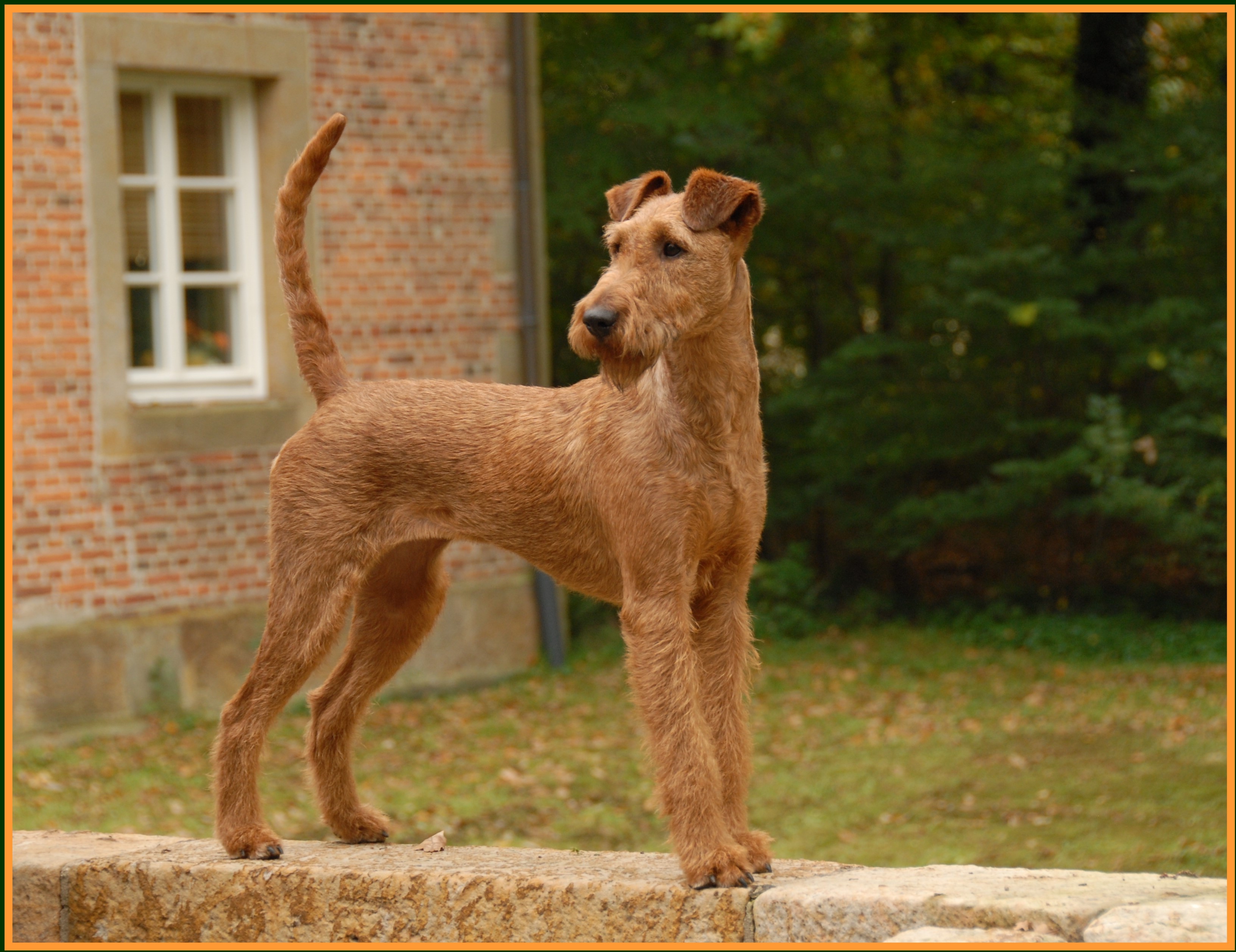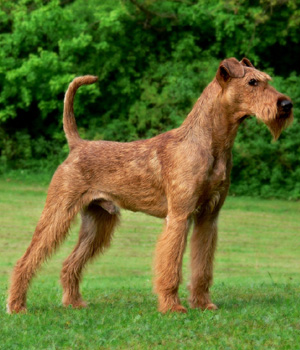
The Breed History
This is one of the oldest terrier breeds, possibly two centuries old.
They may be related to Airedale Terrier, Wheaten Terrier and the
Irish Wolfhound. The wire-haired Black and Tan Terrier may have
been the primary breed ancestor. Early records originated in County
Cork, Ireland. AKC recognition occurred in 1885.
Breeding for Function
They served as a small game hunter, for vermin control, dry and wet
retrieving, guard dog, war dog (messenger, sentinel), police dog, and
were sometimes even used for large game hunting. Today, they are
primarily found in family pet roles. Speed and agility are retained.
Physical Characteristics
Height at Withers: 18" (45.5 cm)
Weight: female 25 lb (11 kg), male 27 lb (12 kg)
Coat: A rich red color, though it can be as light as wheaten (is the
standard). Puppies are sometimes born with some black hair but
as they mature, the normal red color takes over. The wiry dense
hairs overlay a fine undercoat of soft, short, lighter hair. The coat
is harshest over the topline. They require moderate grooming but
bathing needs are minimal. The dog needs stripping once to twice
yearly.
Longevity: 14-15 years
Points of Conformation: Though a terrier, the breed is more similar
to the Irish wolfhound type in their overall lithe conformation
than the typical stocky, short-legged terrier. The skull is long and
narrow between the ears, they possess a minimal stop, and have
a moderate beard and moustache which frame their large black
nose. They have very bushy brows and the lips are black. Eyes are
dark brown with an intense gaze, the ears are small and triangular
in shape with moderate leather and the fold of the ear sits above
skull level. The long neck is moderately muscled and not throaty.
The thorax is deep and somewhat narrow. The topline is long and
slightly arched only over the loin. The metatarsals and metacarpals
are short, the tail is high set, and may be docked to three quarters
of the length. Feet are compact, almost round, the nails dark and
toes well arched. Limbs are long and straight boned, and not
feathered. The gait is lively, animated and powerful.
Recognized Behavior Issues and Traits
Reported breed traits include: Loyal, high intelligence, high-spirited,
fiery attitude, and always on guard. Adaptable, at home in city or
rural environments, and enjoys children. Hardy; tolerates both warm
and cold.
They are playful and affectionate with family members, including
children, but aggressive with other dogs and animals. Their
tendency to have contempt of danger was the genesis to their
nickname of "Red Devil". They may dig, and are considered only
moderately trainable due to stubbornness. Early obedience and
socialization are important for these dogs. They have moderate
exercise needs. If off leash, they require a fenced enclosure.
Normal Physiologic Variations
None reported
Drug Sensitivities
None reported.
Inherited Diseases
Digital Hyperkeratosis (Corny Feet): An autosomal recessive
disease of abnormal hardening and proliferation of the footpads.
Affected dogs develop abnormal footpads around 6 months of
age, which then fissure and crack, predisposing them to secondary
infection.
Hip Dysplasia: Polygenically inherited trait causing degenerative
joint disease and hip arthritis. Too few Irish Terriers have been
screened to determine an accurate frequency.
Patella Luxation: Polygenically inherited laxity of patellar
ligaments, causing luxation, lameness, and later degenerative
joint disease. Treat surgically if causing clinical signs. Too few
Irish Terriers have been screened by OFA to determine an accurate
frequency.
Elbow Dysplasia: Polygenically inherited trait causing elbow
arthritis. Too few Irish Terriers have been screened by OFA to
determine an accurate frequency.
Muscular Dystrophy/Myopathy: A rare, fatal, X-linked muscular
dystrophy affecting primarily male Irish Terriers. This is a dystrophin
deficient form of muscular dystrophy. There is no genetic test for
female carriers.
Disease Predispositions
Hypothyroidism: Inherited autoimmune thyroiditis. 6.1% positive
for thyroid auto-antibodies based on testing at Michigan State
University. (Ave. for all breeds is 7.5%).
Cystinuria/Cystine Bladder Stones: Irish Terriers have an increased
risk for developing cystine bladder stones. Caused by an errorin cystine metabolism. Treat with surgical removal and life-long
medical therapy. Unknown mode of inheritance in this breed.
Progressive Retinal Atrophy (PRA): Progressive degeneration
of the retina, eventually causing blindness. Typical age of onset is
between 2 to 5 years. Presumed autosomal recessive inheritance.
Too few Irish Terriers have been CERF eye examined to determine an
accurate frequency in the breed.
Distichiasis, Persistent Pupillary Membranes, and Cataracts are
reported by CERF, but too few Irish Terriers have been CERF eye
examined to determine an accurate frequency.
Cryptorchidism, Degenerative Myelopathy, Microphthalmia, and
Uveodermatological Syndrome are reported.
Isolated Case Studies
None Reported
Genetic Tests
Tests of Genotype: none
Tests of Phenotype: Recommend patella evaluation, hip and
elbow radiographs, CERF eye examination, thyroid profile including
autoantibodies, and cardiac examination.
Miscellaneous
- Breed name synonyms: Irish Red Terrier
- Registries: AKC, UKC, CKC, KCGB (Kennel Club of Great Britain),
ANKC (Australian National Kennel Club), NKC (National Kennel Club)
- AKC rank (year 2008): 130 (182 dogs registered)
- Internet resources: Irish Terrier Club of America: www.itca.info/
U.K. Irish Terrier Association: www.irishterrierassociation.co.uk
The Irish Terrier Association of Canada:
www.dogbiz.com/itac/index.html
Photo Gallery of Breed - Irish Terrier - Dog Breed








 Animalia Life
Animalia Life